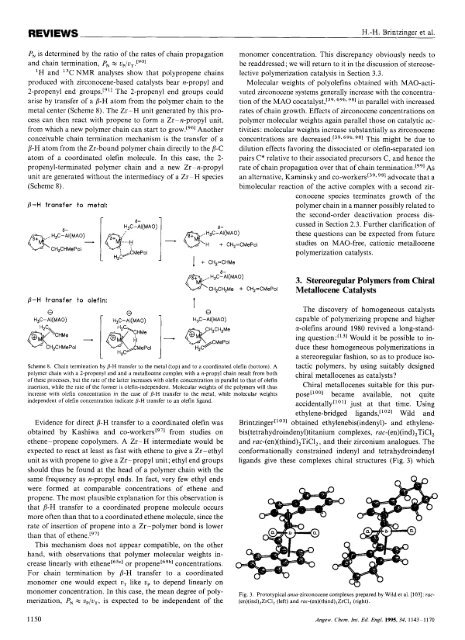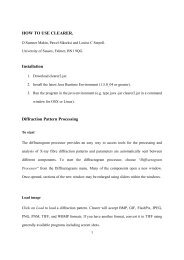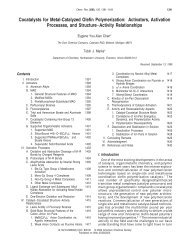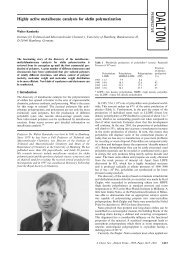Stereospecific Olefin Polymerization with Chiral Metallocene Catalysts
Stereospecific Olefin Polymerization with Chiral Metallocene Catalysts
Stereospecific Olefin Polymerization with Chiral Metallocene Catalysts
You also want an ePaper? Increase the reach of your titles
YUMPU automatically turns print PDFs into web optimized ePapers that Google loves.
REVIEWS<br />
PN is determined by the ratio of the rates of chain propagation<br />
and chain termination, PN zz<br />
'H and I3C NMR analyses show that polypropene chains<br />
produced <strong>with</strong> zirconocene-based catalysts bear n-propyl and<br />
2-propenyl end The 2-propenyl end groups could<br />
arise by transfer of a P-H atom from the polymer chain to the<br />
metal center (Scheme 8). The Zr-H unit generated by this pro-<br />
cess can then react <strong>with</strong> propene to form a Zr-n-propyl unit,<br />
from which a new polymer chain can start to Another<br />
conceivable chain termination mechanism is the transfer of a<br />
b-H atom from the Zr-bound polymer chain directly to the /I-C<br />
atom of a coordinated olefin molecule. In this case, the 2-<br />
propenyl-terminated polymer chain and a new Zr -n-propyl<br />
unit are generated <strong>with</strong>out the intermediacy of a Zr-H species<br />
(Scheme 8).<br />
P-H transfer to metal:<br />
P-H transfer to olefin: t<br />
6-<br />
H.-H. Brintzinger et al.<br />
monomer concentration. This discrepancy obviously needs to<br />
be readdressed; we will return to it in the discussion of stereoselective<br />
polymerization catalysis in Section 3.3.<br />
Molecular weights of polyolefins obtained <strong>with</strong> MAO-activated<br />
zirconocene systems generally increase <strong>with</strong> the concentration<br />
of the MA0 c~catalyst,[~~*~~~~<br />
981 in parallel <strong>with</strong> increased<br />
rates of chain growth. Effects of zirconocene concentrations on<br />
polymer molecular weights again parallel those on catalytic activities:<br />
molecular weights increase substantially as zirconocene<br />
concentrations are decreased.[39s 69b, 981 This might be due to<br />
dilution effects favoring the dissociated or olefin-separated ion<br />
pairs C* relative to their associated precursors C, and hence the<br />
rate of chain propagation over that of chain As<br />
an alternative, Kaminsky and ~ o-workers[~~~~~~<br />
advocate that a<br />
bimolecular reaction of the active complex <strong>with</strong> a second zirconocene<br />
species terminates growth of the<br />
polymer chain in a manner possibly related to<br />
the second-order deactivation process discussed<br />
in Section 2.3. Further clarification of<br />
these questions can be expected from future<br />
studies on MAO-free, cationic metallocene<br />
polymerization catalysts.<br />
CH,CH,Me + CH,=CMePol<br />
Scheme 8. Chain termination by fl-H transfer to the metal (top) and to a coordinated olefin (bottom). A<br />
polymer chain <strong>with</strong> a 2-propenyl end and a metallocene complex <strong>with</strong> a n-propyl chain result from both<br />
of these processes, but the rate of the latter increases <strong>with</strong> olefin concentration in parallel to that of olefin<br />
insertion, while the rate of the former is olefin-independent. Molecular weights of the polymers will thus<br />
increase <strong>with</strong> olefin concentration in the case of fl-H transfer to the metal. while molecular weights<br />
independent of olefin concentration indicate p-H transfer to an olefin ligand.<br />
Evidence for direct P-H transfer to a coordinated olefin was<br />
obtained by Kashiwa and co-worker~[~'] from studies on<br />
ethene-propene copolymers. A Zr-H intermediate would be<br />
expected to react at least as fast <strong>with</strong> ethene to give a Zr-ethyl<br />
unit as <strong>with</strong> propene to give a Zr-propyl unit; ethyl end groups<br />
should thus be found at the head of a polymer chain <strong>with</strong> the<br />
same frequency as n-propyl ends. In fact, very few ethyl ends<br />
were formed at comparable concentrations of ethene and<br />
propene. The most plausible explanation for this observation is<br />
that P-H transfer to a coordinated propene molecule occurs<br />
more often than that to a coordinated ethene molecule, since the<br />
rate of insertion of propene into a Zr-polymer bond is lower<br />
than that of ethene.L971<br />
This mechanism does not appear compatible, on the other<br />
hand, <strong>with</strong> observations that polymer molecular weights increase<br />
linearly <strong>with</strong> ethene[65c1 or pr~pene[~~~] concentrations.<br />
For chain termination by 8-H transfer to a coordinated<br />
monomer one would expect uT like up to depend linearly on<br />
monomer concentration. In this case, the mean degree of polymerization,<br />
PN z up/uT, is expected to be independent of the<br />
3. Stereoregular Polymers from <strong>Chiral</strong><br />
<strong>Metallocene</strong> <strong>Catalysts</strong><br />
The discovery of homogeneous catalysts<br />
capable of polymerizing propene and higher<br />
a-olefins around 1980 revived a long-standing<br />
q~estion:"~] Would it be possible to induce<br />
these homogeneous polymerizations in<br />
a stereoregular fashion, so as to produce isotactic<br />
polymers, by using suitably designed<br />
chiral metallocenes as catalysts?<br />
<strong>Chiral</strong> metallocenes suitable for this purpose['001<br />
became available, not quite<br />
just at that time. Using<br />
ethylene-bridged ligands,['021 Wild and<br />
Brint~inger['~~] obtained ethylenebis(indeny1)- and ethylenebis(tetrahydroindeny1)titanium<br />
complexes, rac-(en)(ind),TiCI,<br />
and rac-(en)(thind),TiCl, , and their zirconium analogues. The<br />
conformationally constrained indenyl and tetrahydroindenyl<br />
ligands give these complexes chiral structures (Fig. 3) which<br />
Fig. 3. Prototypical ansa-zirconocene complexes prepared by Wild et al. [103]: rac-<br />
(en)(ind),ZrCI, (left) and rac-(en)(thind),ZrCI, (right).<br />
1150 Angew. Chrm. Int. Ed. Engl. 1995,34, 1143-1170






